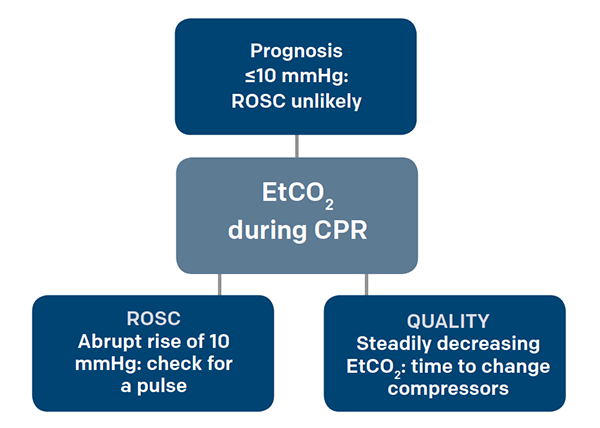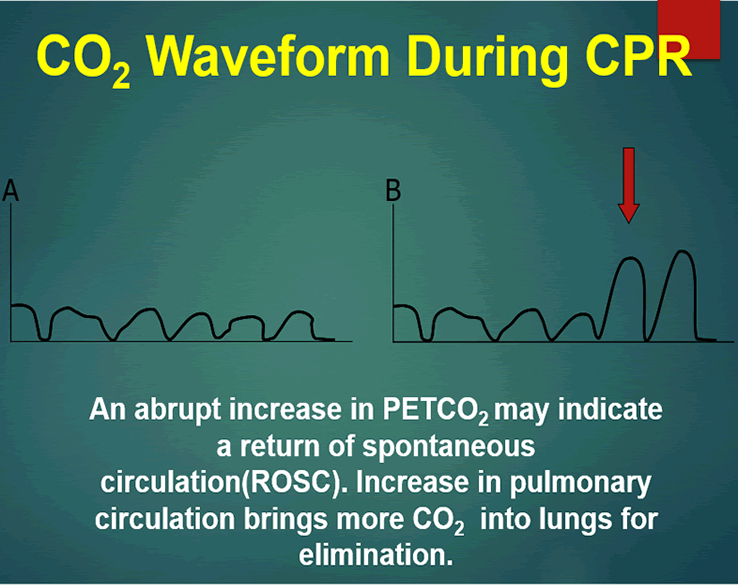low end tidal co2 during cpr
Animals that are breathing spontaneously should have an end-tidal carbon dioxide concentration in the range of 46. Loss of ETCO2 may be the first sign that CPR is needed.

Waveform Capnography In The Intubated Patient Emcrit Project
This was a retrospective cohort study from 1108 to 123112 of all infants 6 month of age who received CPR and had ETCO 2 documented during serial resuscitations in the pediatric PICU or pediatric cardiovascular intensive care units CVICU of Childrens Medical Center of Dallas.

. Also called capnometry or capnography this noninvasive technique provides a breath-by-breath analysis and a continuous recording of ventilatory status. During CPR chest compressions along with positive pressure ventilation restore organ perfusion and oxygenation to some extent. N Engl J Med 1988318607-11.
End-tidal carbon dioxide ETco 2 monitoring provides valuable information about CO 2 production and clearance ventilation. Available evidence has established that ETCO2 measurement can provide an indication of cardiac output and pulmonary blood flow24 Non. An ETCO2 below 10 mmHg is associated with poor outcome.
Carbon Dioxide During the Low Flow State Initiation of CPR. Association between prehospital cpr quality and end-tidal carbon dioxide levels in out-of-hospital cardiac arrest. ETCO2 levels reflect the adequacy with which carbon dioxide CO2 is carried in the blood back to the lungs and exhaled.
End-tidal CO2 ETCO2 detection requires air movement. More Than Just a Number. Here are five things you should know about waveform capnography in cardiac arrest.
Monitoring end-tidal carbon dioxide during weaning from cardiopulmonary bypass in patients without significant lung disease. Ann Emerg Med 1994. Although the normal range for CO2 should be between 35-45mmHg CO2 monitoring gives healthcare providers a lot more insight into what is going on with a patients condition.
Levine RL Wayne MA Miller CC. The higher the ETCO2 measured during compressions the better the perfusion being supplied by CPR. End-tidal carbon dioxide ETCO 2 as measured by waveform capnography is considered a physiologic measure of cardiac output in low-flow states and has been proposed in the 2010 consensus resuscitation guidelines as a possible real-time metric to assess the impact of CPR quality.
End-tidal CO2 as a guide to successful cardiopulmonary resuscitation. ETCO2 is one valuable tool we have to tell us that good quality compressions are being delivered. The amount of CO2 at the end of exhalation or end-tidal CO2 ETCO2 is normally 35-45 mm HG.
Please see the attached link. N Engl J Med. End-tidal carbon dioxide and outcome of out-of-hospital cardiac arrest.
Free Full Text Critical Care. End-tidal CO2 EtCO2 is a noninvasive technique which represents the partial pressure or maximal concentration of CO2 at the end of exhalation. Crit Care Med 198513907-9.
The goal should be to maintain ETCO2 no lower than 10-20 mmHg. Two cases of malignant hyperthermia are described where the earliest sign was a rise in the end-tidal CO2 concentration. End-tidal carbon dioxide concentration during cardiopulmonary resuscitation.
5 In low-flow states such as during CPR delivery of CO 2 to. Falk JL Rackow EC Weil MH. Crit Care Med 198513910-11.
Expired PCO 2 as an index of coronary. You might be confusing end tidal CO2 ETCO2 with arterial CO2 PCO2. On the other hand a high CO2 reading may indicate airway narrowing.
Weil MH Bisera J Trevino RP Rackow EC. Maslow A et al. Decreased presentation of CO 2 to the lungs is the major rate-limiting determinant of the end-tidal CO 2 during periods of low blood flow.
Ensure proper rate approximately 100min Ensure proper depth with adequate releaserecoil of thorax 12 thorax or minimum 25 inches Persistently low EtCO. Ornato JP Garnett AR Glauser FL. Murphy RA Bobrow BJ Spaite DW et al.
Normal value is 35-45 mmHg. It does so because the patient is to. Abrupt increase in ETCO2 suggests ROSC during CPR detectable before pulse check ETCO2 at 20 minutes of CPR is prognostically useful.
Out of hospital quantitative monitoring of end-tidal carbon dioxide pressure during CPR. Ad Full Refund If Your Card Is Not Accepted By Employer. End-tidal carbon dioxide ETCO2 is the level of carbon dioxide that is released at the end of an exhaled breath.
2001Monitoring end-tidal carbon dioxide during weaning from cardiopulmonary bypass in patients without significant lung disease. A low end-tidal CO2 may indicate poor perfusion hypovolemia or sepsis. In fact its commonly called the ventilation vital sign.
End tidal CO2 will stay low unless return of spontaneous circulation occurs. Cardiac output and end-tidal carbon dioxide. Answer 1 of 3.
39 Treveno RP Bisera J Weil MH Rackow EC Grundler WG. Sanders AB Atlas M Ewy GA et al. Online CPR Certification for Workplace Healthcare Providers.
A receiver operator characteristic ROC curve was.

3 Waveform Capnography Showing Changes In The End Tidal Carbon Dioxide Download Scientific Diagram
Emdocs Net Emergency Medicine Educationcapnography In The Ed Emdocs Net Emergency Medicine Education

3 Waveform Capnography Showing Changes In The End Tidal Carbon Dioxide Download Scientific Diagram

Potential Applications Of Capnography In The Prehospital Setting Journal Of Paramedic Practice
End Tidal Co2 The Drummer Of The Vital Sign Band Pem4

Reversible Causes Of Low Etco2 In Cpr Criticalcarenow

Etco2 Valuable Vital Sign To Assess Perfusion The Airway Jedi

Capnography During Cardiopulmonary Resuscitation Current Evidence And Future Directions

The Impact Of Ventilation Rate On End Tidal Carbon Dioxide Level During Manual Cardiopulmonary Resuscitation Resuscitation

Contribution Of Chest Compressions To End Tidal Carbon Dioxide Levels Generated During Out Of Hospital Cardiopulmonary Resuscitation Resuscitation

Use End Tidal Capnography For Placing Orogastric Nasogastric Tubes And Cpr Page 2 Of 4 Acep Now Page 2

Capnography Provides Bigger Physiological Picture To Maximize Patient Care Jems Ems Emergency Medical Services Training Paramedic Emt News

Cpr Mobile Code Stand With Capnograph Capnography

Reversible Causes Of Low Etco2 In Cpr Criticalcarenow

Average Etco2 Kpa During Cpr In Patients With Or Without Rosc Download Scientific Diagram

Capnography Provides Bigger Physiological Picture To Maximize Patient Care Jems Ems Emergency Medical Services Training Paramedic Emt News

Emergency Intubations Capnography

The Role Of Etco2 In Termination Of Resuscitation Jems Ems Emergency Medical Services Training Paramedic Emt News
